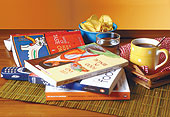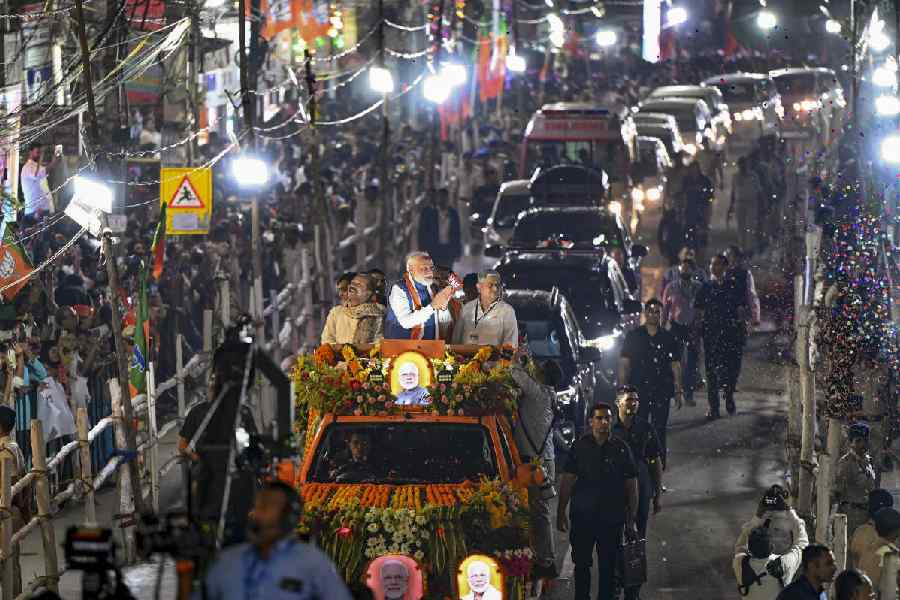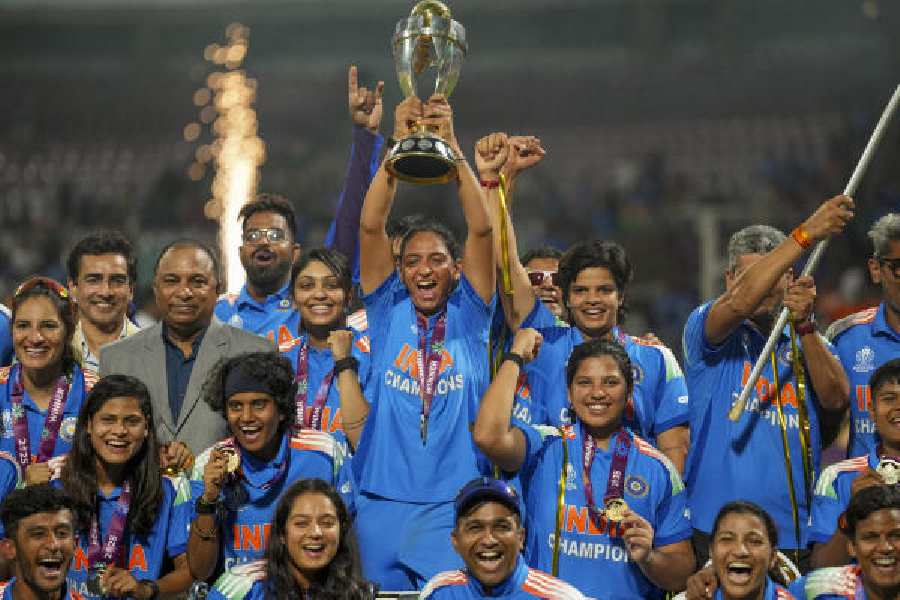 |
For years we were told that there was a book in every one of us. It now transpires that it wasn?t a book after all, but a recipe ? or, perhaps, a food story that had to be told.
Suddenly, food is not just on the table, but in the aired and written word as well. Television channels continue to thrive on cookery programmes. Newspapers and magazines still deliver the kiss of life ? or of death ? to restaurants in and out of town. Publishers have taken food out of the kitchen and into the reading room. And food writing in India ? once just another phrase for cook books ? is reinventing itself as a genre.
Penguin is just out with New Delhi-based columnist Nilanjana S. Roy?s compilation of food writings, called A Matter of Taste: The Penguin Book of Indian Writing on Food. Editor Vir Sanghvi?s much-f?ted book Rude Food, published earlier this year, is going for a reprint soon. In March next year, Penguin will launch Chitrita Banerji?s Life and Food in Bengal, first published 14 years ago by Weidenfeld and Nicolson, London. Roli is working on a series of food books ? from Awadh and Iyer kitchens to flavours and health food ? and Rupa says that food figures prominently among its titles.
?People like reading about food,? says Penguin India executive editor V. K. Karthika. ?Food is not just something for filling a stomach; people want to know more about it,? Rupa publisher Kapish G. Mehra adds.
Gone are the days when a food book meant just a slim volume of recipes written largely by housewives for housewives. Till recently, a food writer meant someone like the prolific Nergis Dalal, the author of several informative cook books, or S. Meenakshi Ammal, whose book of Tamil cuisine, Samaithu Paar, is ? 50 years after it was first published ? still a must-read for anyone wanting that perfect adai.
But that food has a rich context ? and we are not talking about oil here ? was ably underlined in Indian Food: A Historical Companion, written by K. T. Achaya and published by Oxford University Press (OUP) in 1994, and Penguin?s 1995 publication, The Calcutta Cook Book ? which traces the evolution of the city?s food. In 1998, OUP came out with Achaya?s A Historical Dictionary of Indian Food, a comprehensive volume on the genesis of food in India.
?Food books are no longer limited to the kitchen,? says Chitrita Banerji. ?They can be read for the sheer pleasure of reading by people who have no desire to cook but do have an appreciation of food and the cultures that give birth to cuisines,? she says.
Of course, a food book today is often still a cook book ? but what is significant is that it now takes on a myriad other forms as well. Banerji points out that when she started writing Life and Food in Bengal, she was often asked why she was interested in telling people how to cook. ?Today, food writing can be many things to many people,? she says. ?Its possibilities are enormously varied since it covers cookery, science, history, religion, anthropology, travel, and social and cultural practices,? says Banerji, whose new book ? slated to be published by Bloomsbury in 2007 ? examines India ?as a nation of immigrants, from ancient to modern times, through the prism of food and cuisine?.
The focus is on story-telling. Those who have something to say about food do so with an anecdote, in a travelogue, a historical reference, a literary allusion or a regional context. For instance, in Pushpesh Pant?s Buddhist Peace Recipes ? a Roli book of 2004 ? a recipe for kheer comes with the added information that the Buddha broke his fast with a bowl of kheer offered to him by a maiden called Sujata. ?The accent is on good writing,? holds Karthika. ?Sometimes, food is incidental,? she says.
So, Roy?s anthology ? with contributions by, among others, M. K. Gandhi, V. S. Naipaul, Salman Rushdie, Mahasweta Devi and Vir Sanghvi ? is a cornucopia of writings where food is the sub-text. Saadat Hasan Manto?s Jelly is a story of death, Abdul Bismillah writes about food as a religious divide, P. Sainath about the sale of a girl, Bibhutibhushan Bandopadhyaya about a hungry young man in a city and Amitav Ghosh about designer dinners in a Western metropolis. ?There are very few pieces that focus sharply on food,? says Nilanjana S. Roy.
With the text, the form is changing as well. Along with the new writings, there are glossies and big coffee-table tomes ? perfect for some idyllic reading on a winter?s evening. Some, small and easy to hold, are just right for the kitchen. Publishers zero in on the right season for a launch, keeping, as Roli did, a book on sherbets for the summer and one on aphrodisiacs for St Valentine?s Day in February. There are food books based on themes, and volumes on the role of food in weight loss, skin care and beauty treatment. ?What we have to see is how we treat food differently,? says Neeta Dutta, food editor of Roli Books.
But there are some ? such as Vir Sanghvi and food columnist Pushpesh Pant ? who hold that the genre is still to develop in India. Sanghvi stresses that most food writing in the country still tends to focus on reviews of restaurants. ?There is, though, an attempt to make food more accessible to the general reader, to treat food as a part of life,? says Sanghvi.
Pant, who teaches diplomacy in the Jawaharlal Nehru University, maintains that food writing is little more than a fad in columns where haute cuisine goes hand-in-hand with haute couture. ?Everybody who knows nothing about food is writing about it,? says Pant. ?And if you know your salmon, you are really there,? he says.
But, for publishers, food writing is big business. Mehra points out that there is a growing readership and estimates that there has been a twofold increase in sales of food books in the last few years. And Roli editor Renuka Chatterjee, who points out that at least six out of its 12 to 15 illustrative books produced in a year are on food, seeks to stress that along with sales, the quality of food books is on the rise.
There are, many point out, good reasons for the qualitative and quantitative jump. For one, food is no longer just an essential ingredient ? in most parts of metropolitan India, it?s a symbol of celebration. There are many more restaurants in cities and towns than there were a decade ago, and Indians are eating out like never before. And, as Roy points out, with people travelling more and more, food is no longer a subject confined to the dining table ? it?s being tried and tested, and talked of.
?There was a time when poverty was taken seriously and food was not,? Roy says. ?It occupies a space that wasn?t there before. Food is now a form of entertainment for many people,? she says.
Even a decade or two ago, a public celebration of food was seen as a sign of boorishness. No longer, though. ?In the past, you would be embarrassed to say you liked food,? says Chatterjee. ?But now it is fashionable to be a foodie. And it is almost a matter of pride for a serious writer to be seen as a foodie,? she adds.
Not surprisingly, on any given day, an editor in a publishing house is inundated with e-mail and calls from people with food book ideas. ?We have to turn down most of those,? says Datta. And Karthika adds that publishers spend a considerable time politely rejecting offers from people who want to write because they like to cook. More often than not, however, it is the publisher who comes up with new angles for food books. ?Sometimes, we go looking for ideas, and sometimes they come to us,? says Karthika.
Food writing in India has also got a thrust from unexpected quarters ? the Indian diaspora. Food as culture ? or a slice of nostalgia ? finds place in the works of writers such as Rushdie, Ghosh, Rohinton Mistry and Jhumpa Lahiri. ?It can also be a wonderful medium for the exploration of human relationships,? says Banerjee, who is based in Boston.
Clearly, food is not what it used to be. In Achaya?s useful compendium, ahara is listed as the Sanskrit term for food and nourishment. It could do with a new entry. Something like: ?Food ? Figures in varied texts. Also for eating.?











